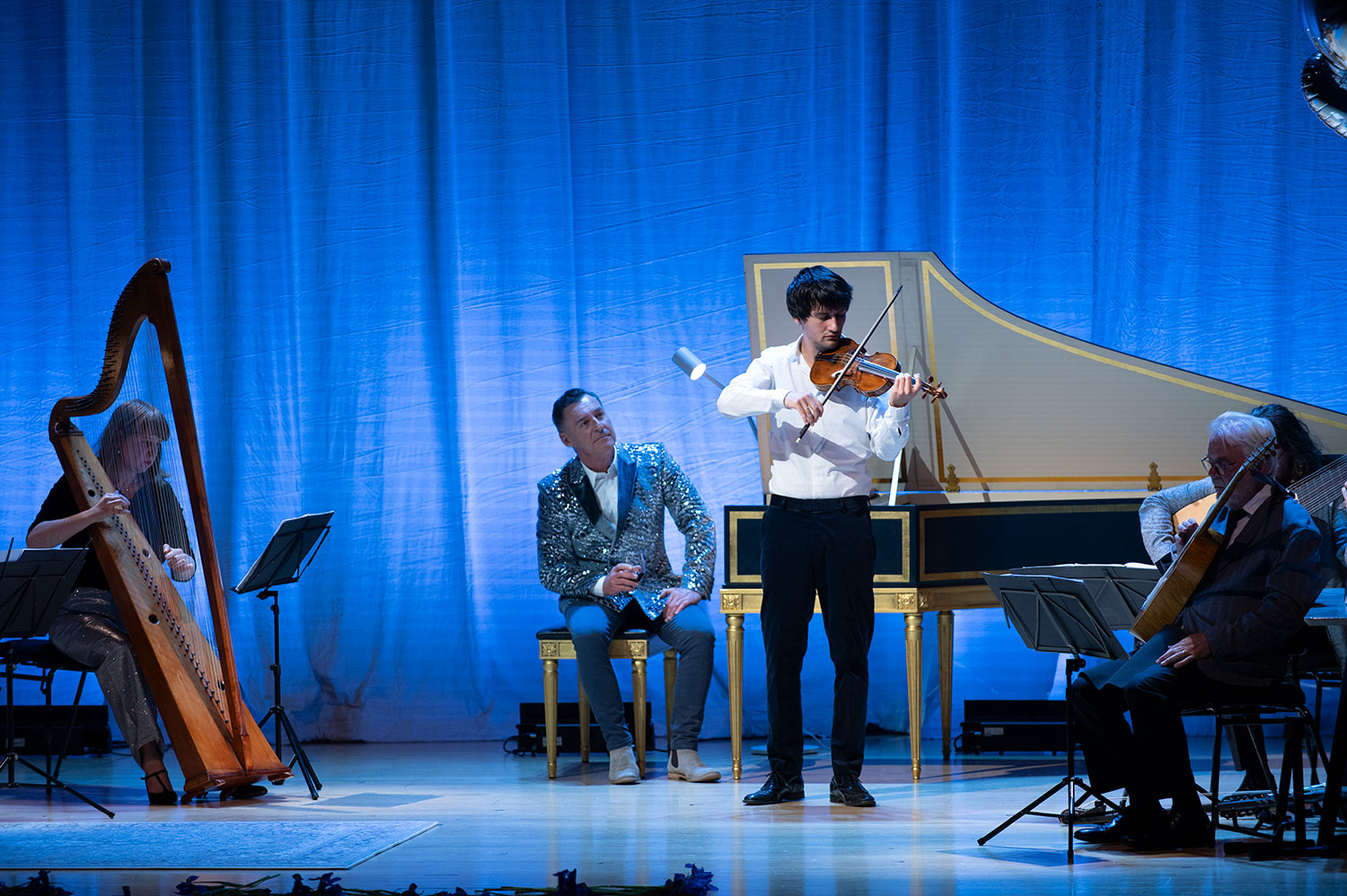An Australian Brandenburg Orchestra concert is always a delight. The program is always thoughtful, and the performance always infectiously alive.
Added to this in The Lover is the quiet virtuosity of an international Baroque violin superstar, Théotime Langlois de Swarte, of Les Arts Florissant fame.
The first half of this concert was dedicated to the theme indicated by its title. It fittingly began with John Eccles’ Aire V from The Mad Lover Suite, which formed the basis of de Swarte’s recent album of the same name with French lutenist Thomas Dunford. It was a haunting piece using a technique of which the English composers of the day were particularly fond – the use of a melancholy descending ‘ground’ in what is essentially a chaconne. The ground is introduced and developed beautifully by theorbists Tommie Andersson and Nicholas Pollock.
The setting is an intimate house party, and de Swarte emerges onto the stage with a wistful smile before picking up where the theorbos left off. It is precisely the sort of music best matched to de Swarte’s mellifluous song-like playing style. Just as the melody seems fleetingly to break free into major mode, yearning upwards, it descends into the darkness of minor mode again to give a delicious chiaroscuro effect.
The next piece, the Adagio from Daniel Purcell’s Sonata Sesta, was similarly reflective. Its long stretched-out notes were played with varying volume and with the slightest vibrato, to give a silvery effect. Nicola Matteis’ Variations on La Folia was, as one would expect, more upbeat. It was precisely the sort of thing in which Paul Dyer revels. He made his entrance just as Andersson began to develop the eight-note theme on Baroque guitar. De Swarte’s exploration of the theme was a frenzied one-man discourse and a tour de force of the art of variation. It has hard not to tap one’s feet.
Matteis Jr’s Fantasia in A minor marked a return to a more contemplative sound-world. It consisted of a series of arpeggios, in a way that was redolent of a Bach partita. Through the density of it all a melody could be gleaned, and this is thanks to the virtuosity of de Swarte, who, mastering the old Baroque ideal, can truly make his instrument sing.
Matteis Sr’s Diverse bizzarrie Sopra la Vecchia Sarabanda ò pur Cíacconna was, like the first piece, based on a ground, but was quite unlike the first piece in mood. It was a jubilant dance evidently based on the same theme as Monteverdi’s Zefiro torna.
Each piece melded seamlessly into the next, and this was assisted in no small part by the delightful improvisations on baroque harp by Hannah Lane. The short musical phrasing given in each piece, and the quick pace, gave the entire ‘narrative’ of the first half a persistent dramatic momentum, though at times it seemed some parts of each piece needed to be given a chance to breathe with a pause.
Eccle’s Sonata Undecimo in G minor was just as haunting as the opening Aire. The Courante was played at an exhilarating speed and de Swarte’s explored the variety of the Baroque violin’s timbre, from ethereal to guttural when played with a deliberately scratchy force. The cascading scales that rounded off the A-section was a moment to behold.
A highlight was Henry Purcell’s Musick for a While from Oedipus, arranged here for violin instead of voice. There were layers to the meaning. Just as the voice is supposed to sing ‘drops’, de Swarte plays staccato and each member leaves the stage one-by-one. It was rounded off with a delightful cadence by Dyer on harpsichord.
Yet most return to play a final piece by Eccles – a variation based on the old English folk tune, John come kiss me now, which was evidently a favourite of the great English virginalists of yesteryear. The ensemble again made best use of the stage setting, with Anton Baba propping his viol on the couch.
The second half of the concert brought with it the entire Australian Brandenburg Orchestra in full force. The program for the second half was distinctly Dyeresque. Charles Avison’s Concerto Grosso No. 5 in D minor was a pastiche of several of Domenico Scarlatti’s lively keyboard sonatas, arranged for a baroque chamber setting. The Orchestra did what it does best – lively music at an exhilarating pace and with infectious energy. The unmistakable A-B form of Scarlatti’s sonatas was clear throughout. De Swarte despatched with the running passages of the A-section of the Allegro with such a remarkably rhythmic ease. And what Ralph Kirkpatrick once called the ‘crux’ that forms at the end of each A-section was most apparent in the closing Allegro. The lively Spanish flavour of the original sonatas was transferred well by the Orchestra into chamber form.
Vivaldi’s Violin Concerto in D Minor, RV 813, was next. The opening Allegro is something of a dramatic mise en scene for what follows. De Swarte’s dramatic flair is shown in punctuating the opening four notes. The third movement featured a series of shimmering tremolos, and all the stylistic techniques and cadences usually employed by Vivaldi.
The concert was closed off with a sunny Allegro from Veracini’s Sonata in A major, Op 1, No 7. De Swart’s virtuosity was again on full display.
But that was not all. The star of the show returned for three encores. The first was Vivaldi’s Winter. The second was the slow movement from Bach’s Harpsichord Concerto in F minor. But in the middle of that delightfully meandering piece, the E string on de Swarte’s original Baroque violin spectacularly snaps. After a quick exchange of violins, he starts from the beginning, with all the virtuosity and stylistic variety that set this concert apart from the very beginning
